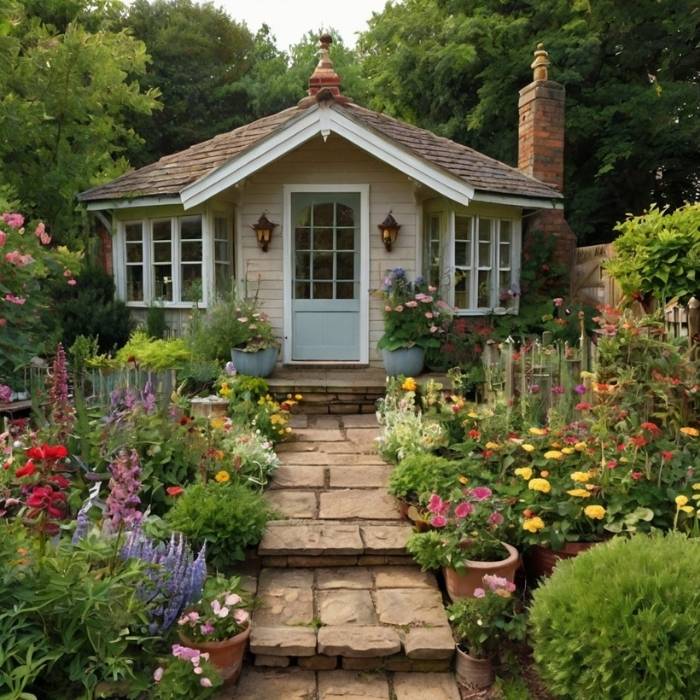Introduction
Cottage garden ideas are a beloved style of gardening characterized by their informal layouts, vibrant plant combinations, and a sense of whimsy. They evoke a feeling of nostalgia and charm, reminiscent of quaint countryside homes. If you’re looking to transform your outdoor space into a picturesque cottage garden, here are some inspiring ideas to help you get started.
Embrace Informality
One of the hallmarks of a cottage garden is its relaxed and informal design. Unlike formal gardens that feature rigid lines and structured layouts, cottage gardens thrive on curves and organic shapes. Consider creating curving pathways made from natural materials such as gravel, brick, or reclaimed wood. These meandering paths invite exploration and create a welcoming atmosphere.
Pathway Ideas
- Gravel Paths: Easy to install and maintain, gravel paths can be shaped into gentle curves that guide visitors through your garden.
- Stepping Stones: Use large stones set in grass or gravel for a rustic look that blends seamlessly with the garden.
- Wood Chips: An eco-friendly option that adds texture and helps with drainage.
Mix and Match Plants
Diversity is key in a cottage garden. Mixing various plants—both flowers and edibles—creates a vibrant tapestry of colors and textures. Aim for a combination of perennials, annuals, and biennials to ensure continuous blooms throughout the seasons.
Recommended Plants
- Roses: A staple in any cottage garden, their fragrance and beauty are unmatched.
- Lavender: Adds color while attracting pollinators like bees and butterflies.
- Foxgloves: Their tall spires create vertical interest and come in various colors.
- Lupins: Known for their dramatic flower spikes, they provide stunning visual appeal.
Consider incorporating some classic cottage garden herbs as well:
- Thyme: A low-growing herb that works well as ground cover.
- Chives: Their purple flowers add color while being edible.
- Mint: Perfect for borders but be cautious as it can spread quickly!
Create Cozy Spaces
A cottage garden should feel inviting and comfortable. Incorporate cozy seating areas where you can relax and enjoy the beauty around you. Think about placing a rustic bench under a flowering tree or creating a small nook with chairs surrounded by fragrant plants.
Seating Ideas
- Garden Benches: Choose weathered wood or wrought iron for an authentic feel.
- Hammocks: Perfect for lazy afternoons spent reading or napping.
- Arbors with Seating: Create an intimate space by adding seating under an arbor draped with climbing plants.
Blur the Boundaries
To create a seamless transition between your garden and its surroundings, choose plants that spill over pathways or climb fences. This technique softens the edges of your garden and makes it feel more integrated with nature.
Plant Choices for Blurring Boundaries
- Clematis: A climbing plant that can adorn fences or trellises with stunning flowers.
- Morning Glories: Fast-growing climbers that add vibrant colors to vertical spaces.
- Lady’s Mantle: With its cascading foliage, it can soften edges beautifully.
Use Vertical Elements
Adding vertical elements such as trellises, arbors, or obelisks can enhance the visual appeal of your garden while providing support for climbing plants. These structures serve as focal points or frame entrances to different sections of your garden.
Vertical Structure Ideas
- Trellises: Ideal for supporting climbing roses or peas.
- Arbors: Create an enchanting entrance to your garden path.
- Obelisks: Perfect for showcasing climbing plants like sweet peas or morning glories.
Incorporate Edibles
A true cottage garden often includes edible plants alongside ornamental ones. This not only enhances the beauty of your space but also provides fresh produce right at your doorstep. Consider integrating herbs like basil, parsley, or dill into your flower beds.
Edible Plant Suggestions
- Strawberries: Their bright red fruit adds color and sweetness.
- Tomatoes: Choose heirloom varieties for unique shapes and flavors.
- Zucchini: With its large leaves and bright yellow flowers, it’s both productive and attractive.
Add Decorative Features
Incorporating whimsical elements such as vintage tools, decorative pots, or charming birdhouses can add character to your cottage garden. These features make your space feel more personalized and inviting.
Examples of Decorative Features
- Old Wheelbarrows: Use them as planters filled with colorful annuals.
- Moss-Covered Statues: Add an enchanting touch that blends with nature.
- Lanterns or Fairy Lights: Create a magical ambiance in the evenings; they can transform your garden into a fairy tale setting.
Focus on Color Palettes
Cottage gardens are known for their romantic color schemes. Soft pastels like pinks, blues, yellows, and whites work beautifully together to create a soothing environment. You can also experiment with bolder colors for a more vibrant look; just ensure that the combinations feel harmonious rather than chaotic.
Color Combinations to Consider
- Pastel Palette: Combine soft pink roses with pale blue delphiniums and white daisies.
- Bold Contrast: Pair deep purple asters with bright yellow sunflowers for striking visual impact.
Maintain Healthy Soil
Healthy soil is crucial for thriving plants. Incorporate organic matter such as compost into your soil to improve its structure and nutrient content. Regular mulching helps retain moisture and suppress weeds, ensuring that your plants have the best possible growing conditions.
Soil Improvement Tips
- Compost Regularly: Create a compost pile using kitchen scraps and yard waste to enrich your soil naturally.
- Mulch Your Beds: Use straw or bark chips to retain moisture and suppress weeds effectively.
- Test Soil pH: Ensure optimal growing conditions by testing soil pH levels; most plants prefer slightly acidic to neutral soil (pH 6.0 – 7.0).
Seasonal Interest
To keep your cottage garden looking beautiful year-round, choose plants that offer seasonal interest. Spring bulbs like daffodils and tulips can herald the arrival of warmer weather, while autumn perennials like asters extend color into the fall months. This approach ensures that there’s always something blooming in your garden.
Seasonal Planting Suggestions
- Spring Bloomers: Daffodils, tulips, hyacinths
- Summer Stars: Peonies, coneflowers, daylilies
- Fall Favorites: Mums, sedums, ornamental grasses
Conclusion
Designing a Cottage garden ideas is about embracing creativity and personal expression while celebrating nature’s beauty. By mixing plants, incorporating cozy spaces, adding decorative features, and maintaining healthy soil, you can create an enchanting outdoor sanctuary that reflects your unique style. Remember to keep it informal—let nature guide your design choices—because the charm of a cottage garden lies in its delightful unpredictability!With these ideas in mind, you’re well on your way to crafting a stunning cottage garden that not only enhances your property but also provides a peaceful retreat where you can unwind amidst nature’s splendor. This version expands on each section while maintaining clarity and engagement throughout the content. Let me know if you need any further adjustments!

